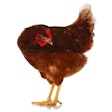
Declining numbers of reported highly pathogenic avian influenza (HPAI) cases offer further evidence that the worst of the 2023-2024 HPAI “season” may now have passed in Europe.
Over the past week, new outbreaks have been reported in poultry flocks in just two countries in the region. Among wild populations, just four states have confirmed new cases. Furthermore, a growing number of countries and administrative areas have officially declared outbreak series “resolved.”
The two European states registering new outbreaks in commercial poultry are Bulgaria and Hungary. This is according to the latest official notifications from their national veterinary agencies to the World Organisation for Animal Health (WOAH) received over the past eight days.
For Bulgaria, the latest outbreak affected a flock of almost 154,000 poultry in mid-April. The farm was located in the central province of Plovdiv — where six previous outbreaks have been confirmed since the start of 2024. It brings the country’s outbreak total in this population so far this year to 14. Directly impacted have been around 795,000 commercial birds across six Bulgarian provinces.
Meanwhile, a new HPAI outbreak wave in the southeast Hungarian county of Bekes has hit a sixth farm. Numbers of birds affected have not been included in the WOAH notifications to date.
In both countries, the HPAI virus serotype involved has been identified as H5N1.
HPAI situation in European poultry, captive birds
So far this year, 144 HPAI outbreaks in commercial poultry flocks have been recorded in 16 European countries (as of April 19). This is according to the Animal Disease Information System from the European Commission (EC). It monitors the disease situation in European Union (EU) member states and neighboring countries.
Compared with the previous edition dated April 12, the number of outbreaks has risen by six — five in Hungary and one in Bulgaria.
The highest national total since the start of the year is 55 outbreaks in Moldova, followed by Poland (with 25), although neither country has added to its total since early March.
For comparison, the EC System recorded a total of 521 outbreaks in poultry across 24 countries during the whole of 2023.
The EC System separately records HPAI outbreaks in non-commercial poultry, zoos, and similar premises in the category “captive birds.”
Seven European countries have registered a total of 46 outbreaks affecting this population so far in 2024 (as of April 19). No new cases in this category have been reported since mid-March.
Last year, 15 countries registered with the EC a total of 99 HPAI outbreaks in captive birds.
At the end of March, Great Britain self-declared zonal freedom from HPAI, and last week, it was announced that poultry gatherings can resume from April 26.
According to the government’s agriculture department, Defra, this applies not only to poultry, but also to captive birds such as ducks and geese. Only condition is a requirement to notify the Animal and Plant Health Agency in advance of the event.
Slow rise in cases among wild birds in Europe
Just four of the region’s countries have reported to the EC or WOAH new HPAI cases in wild birds over the past 8 days.
So far in 2024, the EC System total in this category has reached 383 outbreaks from 26 countries (as of April 19).
Compared with the edition dated April 12, this is an increase of just four — two in Germany, and one each in Denmark and Norway.
For the year to date, Germany has the highest total in this category at 135, followed by Denmark (now with 73), and Romania (23).
Additionally, Slovenia has confirmed to WOAH one new case in a wild bird — a swan.
HPAI threatens future of native breeds
Publication of the latest annual review from the Rare Breeds Survival Trust (RBST) in the United Kingdom (U.K.) raises concerns for the future of the country’s native poultry breeds.
Commenting on the list, trustee Tom Davies said that HPAI represents a continuing threat to rare birds.
"Under the continued threat of avian influenza, there is a clear decline in active breeding programs,” he said, “and when breed populations are so low, losing flocks can be devastating.”
Davies called for government action to encourage more people to keep these birds, and work with RBST and breed societies to help conserve them for the future generations.
Update on influenza in European mammals
In June of last year, the H5N1 HPAI virus was detected for the first time on Finland’s fur farms. Finally last week, the authorities declared to WOAH that the disease situation had been “resolved.”
The declaration followed confirmed outbreaks at 75 locations, involving mainly commercial farms with species such as Arctic foxes, American mink, red foxes, and raccoon dogs, and sable. Including a handful of infections in animals living wild, outbreaks affected just over 472,000 individuals. Of these, 14,800 died, and the rest of the farmed animals have been culled.
In November of 2022, an outbreak of HPAI linked to the H5N1 virus serotype occurred in a small group of bush dogs kept in captivity in the U.K. Within a few days, 10 of the 15 animals in the pack died.
In recent days, a subsequent study has been published, which points to infected meat as the most likely source of infection in this outbreak. This is according to a new scientific paper released on BioRxiv ahead of peer review.
Native to Central and South America, the bush dog (Speothos venaticus) is described as a “near threatened species of wild canids that are of conservation concern.”
View our continuing coverage of the global avian influenza situation.

















